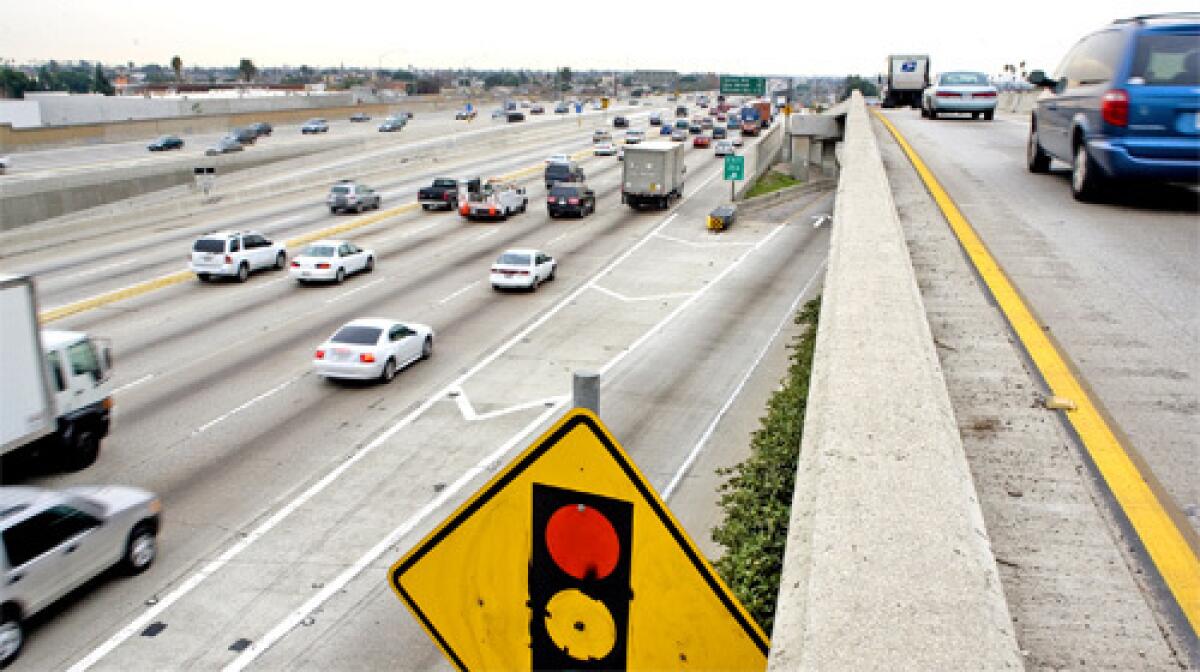Plan for toll lanes on L.A. County freeways is in fast lane

- Share via
If they can win a huge federal grant, Los Angeles County transportation officials said Tuesday that rush-hour toll lanes could become a reality on three local freeways by spring 2009.
The prediction underscored what has been a radical turnaround for leaders who only eight months ago were reluctant to do anything more than study “congestion pricing” as a way to discourage drivers when freeways are clogged.
That hesitation caused Los Angeles to miss out last year on a share of more than $1 billion in federal assistance. But another round of federal money will be in play over the next two months, and officials hope their change of heart will help them snag the $648 million needed to set up the toll lanes and make other transportation fixes.
During a briefing for reporters, MTA and Caltrans officials acknowledged that toll lanes remain controversial in Los Angeles, though they have been used for years on one freeway in Orange County. But the time is right, they said, to try something new in a region with among the worst traffic in the nation.
“I know that this has caused a lot of conversation,” said Roger Snoble, chief executive of the Metropolitan Transportation Authority. “We have to do something. It’s really pretty evident to us that things are getting worse.”
Snoble added: “We’ve been stuck in the same old rut.”
The plan would convert existing carpool lanes into toll lanes on 85 miles of three freeways: the 110 between downtown Los Angeles and the Artesia Transit Center at 182nd Street; the 210 between downtown Pasadena and the 605; and the 10 between downtown Los Angeles and the 605.
A second phase would convert carpool lanes on the 10, 210 and 60 freeways from the 605 to the San Bernardino County line. On the 60, a carpool lane under construction east of the 605 would have to be completed first.
The ambitious plans would be contingent on the region’s winning that chunk of federal money. The MTA and Caltrans overall want to spend $1.4 billion on a variety of transportation fixes that would include the toll lanes.
The U.S. Department of Transportation held a competition last year for cities or regions willing to deploy congestion pricing as part of their traffic-busting plans. Promising only to study the concept, Los Angeles County officials were bounced from the competition in the first round.
After receiving public heat for that failure, the MTA board -- composed mostly of elected officials from across the county -- voted 12 to 0 to try again.
The premise behind congestion pricing is to control freeway flows by charging a toll that fluctuates depending on the volume of traffic. If traffic is heavy, the price goes up. When traffic is light, the price goes down.
The portion of the 91 that connects Orange and Riverside counties is the only Southland freeway with congestion pricing in place. Tolls range from as low as $1.20 to as high as $10 from 3 p.m. to 4 p.m. on the eastbound side on Friday afternoons.
The tolls that Los Angeles County freeway drivers might pay have not been decided.
Snoble and Douglas Failing, director of the local California Department of Transportation district, hedged on one potential sticking point that has emerged in the last month: whether multi-passenger vehicles would also have to pay to use lanes they currently travel in free. MTA officials have said pricing schemes would probably be tiered, with single-occupant vehicles paying the most but all drivers possibly paying something.
Snoble and Failing said there was still a chance that carpoolers would not be charged -- especially those driving on the 110 freeway, which has two carpool lanes in each direction and the ability to handle more vehicles.
Critics of the toll plan say people who carpool shouldn’t be charged, since they’re already doing something that benefits other motorists.
MTA board member Richard Katz agreed and said Tuesday that he has received complaints from people upset that carpoolers might have to pay.
“There is no interest in charging carpoolers to use carpool lanes, even if we do charge single-occupancy vehicles,” Katz said.
The impending application for federal transportation money does not answer a related question either: If tolls are based on the number of people in a car, how do authorities verify that number?
No toll booths are expected to be built. Use of the lanes would probably be monitored by electronic devices that motorists would be given to put in their cars.
Snoble and Failing said there are tools -- such as cameras and heat sensors -- that authorities could use to monitor occupancy and issue citations to cheaters. But Failing said he could see how problems might result if a heat sensor detected a “passenger” who turned out to be a big dog.
Congestion pricing is not the only controversial idea on the plate of local transportation officials these days. The MTA conducted a poll in November to gauge whether residents might be open to a tax increase to pay for mass transit projects such as the “subway to the sea,” according to two sources familiar with the survey.
The results showed that residents were fed up with traffic and were open to a tax hike, but would still have to be persuaded for any such increase to pass. A daylong conference Thursday organized by the Subway-to-the-Sea Coalition will explore the subject further.
More to Read
Sign up for Essential California
The most important California stories and recommendations in your inbox every morning.
You may occasionally receive promotional content from the Los Angeles Times.










